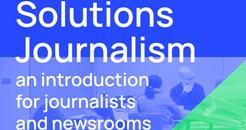 Solutions Journalism
Solutions Journalism
From the European Journalism Centre
Research shows that many people avoid the news, as they get tired of hearing only about natural disasters, war, crime, suffering etc. All this negative reporting has an impact on their mood, well-being and their trust in journalism. News-avoiders are more interested in positive or solutions-based journalism and less interested in the big stories of the day.
So there’s an important role to play for the media to counter intentional news avoidance. Editorial teams are able to change news content to make it less negative and more constructive, less opinionated, more fact-based and transparent.
The aim of this more balanced approach to journalism is to underline that consumers are not simply passive victims of the news, but they can engage with answers and collectively create a world in which hope is possible. It replaces their feeling of helplessness and stress with a feeling of belonging and a sense of being able to make a difference in society.
So Solutions Journalism investigates and explains, in a critical and clear-eyed way, how people try to solve widely shared problems. While journalists usually define news as “what’s gone wrong,” solutions journalism is leading an effort to expand that definition: responses to problems are also newsworthy. By adding rigorous, evidence-based coverage of solutions, journalists can tell the whole story.
To avoid fluffy or overly positive news simplifying the issues covered, Solutions Journalism Network (SJN) recommends using the four pillars to ensure a well-balanced coverage of solutions:
-
Response - Features not just a person or an organisation, but a response to a problem and how it happened.
-
Insights - Seeks to provide insights that can help others respond — not just inspiration.
-
Evidence - Provides available evidence - data or qualitative results, looking at effectiveness (or lack thereof) — not just intentions.
-
Limitations - Discusses limitations, a response’s shortcomings and avoids hype.
“Addressing problems is important, but equally crucial is showcasing existing solutions. It demonstrates people’s awareness and active efforts to fix the issues, providing inspiration and tools for young readers who may feel the world is doomed.” Juliette Gerbais, European Journalism Centre
Download a guide here.
Based on your social action experience, why not create articles to place in the press?
Retweet about this article:
From the European Journalism Centre, 27/08/2024